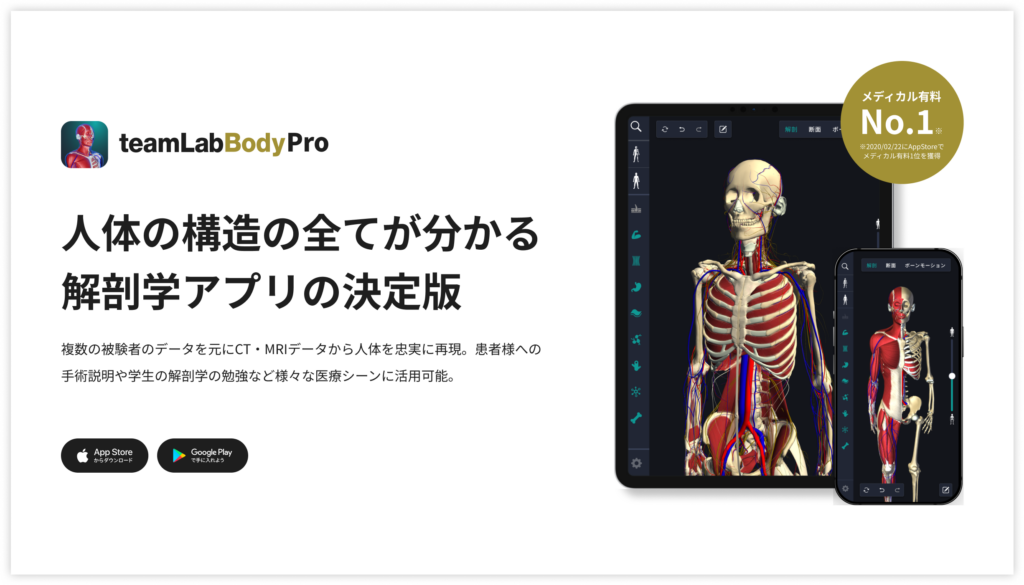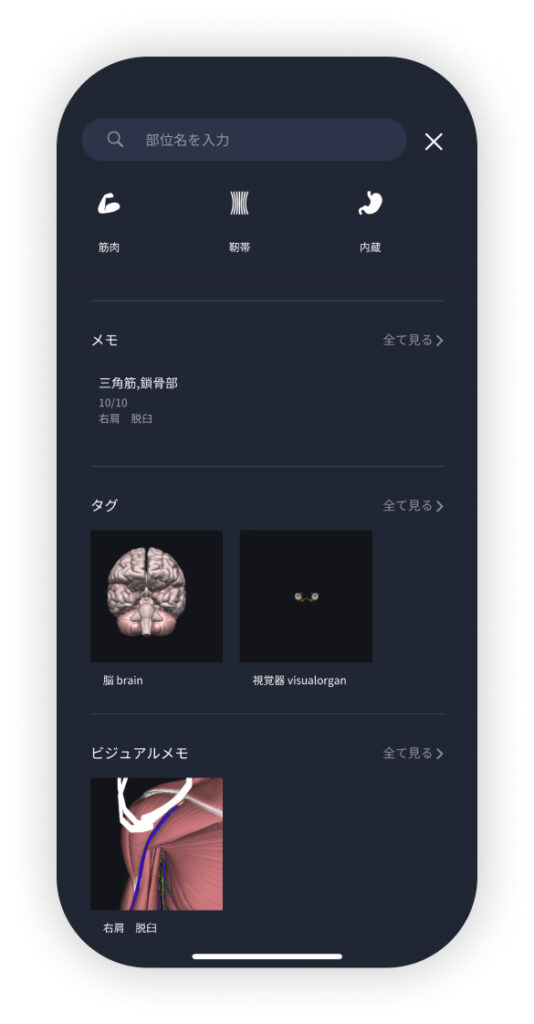beginning
In this article, I will explain effective study methods, starting with knowledge of specialized parts in human anatomy.
In human anatomy, it is necessary not only to memorize the names of various organs, muscles, and bones, but also to remember where they are located in the body. Therefore, it is necessary to learn as efficiently as possible.
I hope you will deepen your understanding even a little by reading this article and using the app.
Now, I will explain the contents of the “posterior atticular occipital membrane” and how to study human anatomy.
teamLab Body Pro Free Download
A 3D anatomy app that shows all the structures of the human body
Download teamLab Body Pro here!

What is posterior atticular occipital membrane?
The anatomy application allows you to view a selection of anatomy 3D models. In this model, there are various observation methods such as surfaces, cross-sections, and nervous systems. This time, I'll explain using an anatomy application.
About posterior atticular occipital membrane

The posterior atlanto-occipital membrane (posterior atlanto-occipital membrane) is a ligamentous structure that exists between the occipital bone of the skull and the first cervical vertebra (annular vertebra, C1), and connects the posterior arch of the atticular spine to the scales of the occipital bone.
This membrane plays a role in stabilizing the upper cervical vertebrae and skull, and in particular, it has the function of limiting hyperextension of the head. In addition, this membrane is located on the upper edge of the vertebral foramen of the atypical spine, and there is a part that transitions from the medulla oblongata to the spinal cord just below it, and it is also an important anatomical landmark through which cranial nerves and blood vessels pass. Since the vertebral artery passes through the outside of the membrane, the posterior atlantooccal membrane also functions as a “roof” for this artery's tunnel.
Clinically, membrane thickening and fibrosis in this area may compress the vertebral artery, and this may be involved in conditions such as “vertebral artery anatomical stenosis” and “posterior cervical vertigo.” Therefore, it is important to understand not just ligaments, but also the surrounding structures.
Also, it is difficult to accurately depict this membrane with imaging diagnosis (MRI or CT), and there are cases where clinical reasoning and manual evaluation are key. Although structurally small, it is an important area requiring neurological and angiological understanding.
Study points
Anatomical understanding: location and structure of posterior atticular occipital membrane
The posterior atticular occipital membrane is a ligament that bridges the space between the occipital bone and the annular vertebrae, and stretches from the posterior arch of the atticular spine to the edge of the large occipital foramen of the occipital bone. The outer part of this membrane is in contact with the “arterial groove” for vertebral arteries to pass through, and it exists to cover the artery. First, let's check the positional relationship between the occipital bone and the annular vertebra using a 3D model or bone model. In particular, if you understand the relationship between the foramen magnus and the posterior atrial arch, it becomes easier to grasp the running image of the membrane. Since the structure is small, it is important to check the diagram repeatedly.
Functional understanding: movement restrictions and neurovascular protection
The posterior atticular occipital membrane has the function of suppressing head hyperextension and is involved in the stability of the upper cervical vertebrae. Also, the top of the spinal cord is located directly below the membrane, and it also plays a protective role for vertebral arteries that pass through the membrane. It is also effective to experientially learn “which structure controls this movement” through the movement of turning one's neck backwards. Furthermore, by imagining the running of an artery while palpating the neck, the understanding of anatomy is further deepened.
Practical application: Utilized for clinical evaluation of posterior neck
The posterior atticular occipital membrane is clinically important as a transit part of the vertebral artery. Fibrosis or thickening of membranes can compress arteries and cause impaired blood flow. For example, unspecific symptoms, such as dizziness or visual abnormalities, may also be the cause of this area. The “vertebral artery anatomy test,” where symptoms are induced by manually extending and rotating the neck, presupposes understanding the positional relationship between this membrane and the artery. In addition to structure, the link between dynamic assessment and clinical findings is key.
How to study human anatomy
I will explain specific study methods using human anatomy applications.
Check your past learning history and practice repeatedly
Here are the steps to check your anatomy learning history and practice iteratively effectively.
1. Check your learning history in the app
Reviewing your learning history with the application is an important step in effectively advancing anatomy learning. First, launch the app and go to the learning history section from the main menu. Many anatomy apps are designed to show your progress in the form of graphs and lists, so you can visually check which parts you've learned about and how much time you've spent.
By using this data, you can understand which areas you have strengths in and where you need to spend more time and effort. We also recommend using a dedicated tag or notebook function to mark areas you are particularly weak at or where you need to relearn. Regularly checking your learning history and looking back on past learning content will lead to efficient review and deepening understanding.
2.Make a plan for iterative learning
Making an efficient repetitive learning plan based on learning history is extremely effective in promoting knowledge retention. First, identify weak points and areas where you need to relearn. Next, arrange these study items into a weekly or monthly calendar and create a specific study schedule. By proceeding in a planned manner, you can learn each part evenly and avoid packing in a large amount of information at once.
Using a task management app or digital calendar to set study reminders is effective. Also, it's important to have the flexibility to regularly review progress and revise plans as needed. By having goals and proceeding with your studies in a planned manner, you can efficiently acquire anatomical knowledge.
3.Use 3D features to learn visually
By utilizing the 3D function, learning anatomy is easier to understand visually. The 3D model shows the structure of the human body three-dimensionally, and each part can be observed in detail. This makes it possible to intuitively grasp positional relationships between deep muscles and organs that are difficult to capture in a planar view. For example, you can learn even the smallest details by rotating specific muscles and bones and zooming in and out.
Also, there are many apps that have the function of displaying cross-sectional views of each part using a 3D model, which is useful for deepening understanding of internal structures. This diversity of visual information helps with memory retention and improves immediate responsiveness in tests and practice situations. By utilizing the 3D function and learning visually, you can learn anatomy knowledge more deeply and efficiently.
Use the memo function concretely

Make notes so you don't forget the things and points you've noticed while studying. The memo function can be used for different purposes, such as inputting text, saving images, and writing memos. Tag your notes to make them easier to review later.
Test your learning regularly in the form of quizzes
Regularly testing what you've learned in a quiz format is a very effective way to anchor your anatomy knowledge. Quiz-style tests help you objectively grasp your level of understanding and areas you lack while repeating knowledge.
For example, by using a learning app to conduct quizzes every specific period, you can reconfirm what you've learned and strengthen your memory. There are a wide range of quiz formats, such as multiple choice questions, fill-in-the-blank questions, and short answer questions, and each helps understanding from a different angle and develops the ability to utilize various types of knowledge.
Get feedback
If possible, get feedback from other learners and experts. It helps you find your own gaps in understanding and areas for improvement. You can also keep yourself motivated to learn by regularly testing yourself. Feeling a sense of accomplishment and progress increases motivation for continuous learning.
summary
This time, I explained how to study about the “posterior atticular occipital membrane” using an application!
Thank you for reading this far.
I would be happy if reading this article helped you learn about anatomy.
Learning is a long, never-ending journey, but I sincerely wish you all the best. Let's continue to study together and work hard for the national exam!
Please look forward to the next blog.
teamLab Body Pro Free Download
A 3D anatomy app that shows all the structures of the human body
Download teamLab Body Pro here!





